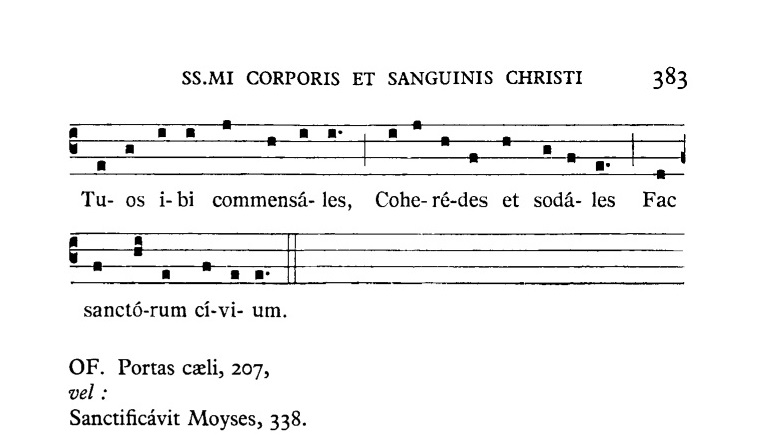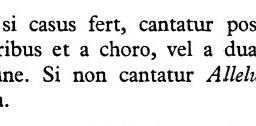Sequences
-
The subject has probably been covered... many times. In preparing chant settings of all official (Missal and Lectionary) English texts, I realized I should probably include the Sequences. The texts are available on the usccb.org site, along with the readings of the day. While setting these texts to the traditional chant melodies, I encountered various problems with the textual vs. musical scansion, a result, it would seem, of their use of a fine old English translation that has been corrupted (updated, if you prefer) to reflect modern tastes. The attached end to Lauda Sion is the most egregious example.
I have chosen to solve these problems as I see fit, figuring other sources are available, or that music directors will make their own decisions (like singing them in Latin, as they should be). But is it generally agreed that, when it comes to singing as opposed to reciting the Sequences, any translation can be used? or any previously official translation? or any translation sung by more literate English speakers than the American bishops would seem to be?
 LaudaSion.pdf20K
LaudaSion.pdf20K -
I thought there was no amen or alleluia after the sequence in the novus ordo? I was under the impression that any translation or paraphrase is allowed for the sequences. I know of a parish where the hymn "Christ the Lord is risen today, Christians haste your vows to pay" is sung in place of "Victimae paschali laudes," and as far as I know, that's perfectly acceptable, even if not ideal. Even more so for the Corpus Christi sequence, which is optional. A fine English version in modern notation was posted in an earlier thread.
-
The lectionary equivalent of Lauda Sion is a moderately doctored up version of Neale's translation (which perfectly fits the historic plainchant melody). This presents some rather stupid non rhyming couplets and several metrical embarrassments. My solution is to sing Neal as Neal wrote Neal. This has caused no ruckus or complaint. I would do the same for any other savaged Neale version in the lectionary - I would 'fix' it. If it's not a Neale translation one is on shakier ground. Also, I find it disappointing and inexcusable that none of the lectionary versions of the sequences allow for the 'alleluia' that historically follows the 'amen'. Most people are unaware that this alleluia ever even existed. Amen goes re-mi-re . do . re, and the alleluia goes do . fa . mi-re . re.Thanked by 1CHGiffen
-
The dropped alleluia at the end of the sequence (in the Lectionary) seems related to the rubrical change about when the sequence is to be sung.
Traditional order:
"Alleluia, alleluia" -- alleluia verse -- sequence -- "alleluia".
GIRM order:
Sequence -- "Alleluia, alleluia" -- alleluia verse -- "alleluia".
-
Actually, I had thought about that and drawn that conclusion, Chonak.
It is change for change's sake - they wanted 'alleluia' before the Gospel. There was one at the close of the sequence. It wasn't thought good enough for them, so they jettisoned it and scrambled everything around. More mutilation from our (un-)friendly and oh-so-chic 'liturgists'.
(Sequences are still sung where they belong in the Ordinariate - and we add their alleluias.) -
Oh! Poor, poor people - it just wouldn't do to have them actually stand for a sequence, would it!
Actually, that's one thing that I have always thought was odd about Catholics - they don't stand to sing unless it is for the procession or the dismissal - they just sit there. Everyone else stands for offertory hymns and other hymns (except communion hymns, for which they are kneeling). The common formula is 'stand to praise, sit to be instructed, kneel to pray'. There is a certain logic to that.
At Walsingham (and throughout the Ordinariate) we sing the sequence where it has belonged for millennia - the people not only stand for it - they sing it!Thanked by 1tomjaw -
Seems bizarre to delete the rhyme with the modernized forms instead of the original verbs ("bestowest" and "knowest"). Pace the hand wringing of some liturgists, I think people can still understand these archaic forms and would have no scruple using them, especially in a musical setting. Perhaps there is a way of convincing the powers that be?
About the "alleluia" at the end - it does appear in the Graduale published in 1974 [INCORRECT - see below], at which time the sequence was still sung after the alleluia. Evidently the order was switched with the 3rd edition of the Roman missal.Thanked by 1Elmar -
The missal rubric for the obligatory Sequence (c.f. GIRM #64) and the instruction in the ordo wants missæ (Prænot. #8) are (famously) contradictory.
I think it's certain sure that this arises because whereas the traditional Roman liturgy the Alleluia (or Tract) is a liturgical act on its own followed (sequor) by the Sequence, so in the "modern papal Mass", there is no Alleluia, but instead a "gospel acclamation" which is part of the ritual of reading the Gospel. The Sequence doesn't make sense as an extension of that, so it's left on its own, preceding the Gospel with its acclamation and the Dominus vobiscum.
(It's true that the GIRM asserts that the Gospel Acclamation is a "rite or act in itself", but what it goes on to describe, and what is done in practice, shows that it is not, it's absolutely part of the Gospel reading. ) -
Which explains that it contradicts Praenot.8 of the 'Orde cantus Missae' [obsolete point as a consequence].About the "alleluia" at the end - it does appear in the Graduale published in 1974[INCORRECT - see below], at which time the sequence was still sung after the alleluia. Evidently the order was switched with the 3rd edition of the Roman missal.
Thanks, rich_e, for the link to the earlier discussion!
With respect to the switching, the Holy See went only half way ... and retained the term "Sequentia" ('that which goes after') rather than changing it into "Praecedentia" ('that which goes before') - those traditionalists! ;-) -
Do you have a different printing? The PDF edition is clear that the amen and alleluia are to be omitted.About the "alleluia" at the end - it does appear in the Graduale published in 1974, at which time the sequence was still sung after the alleluia.


 Sequence rubric.jpg647 x 126 - 33K
Sequence rubric.jpg647 x 126 - 33K
 Seqence ending.jpg761 x 445 - 67KThanked by 1Elmar
Seqence ending.jpg761 x 445 - 67KThanked by 1Elmar -
Seems bizarre to delete the rhyme with the modernized forms instead of the original verbs ("bestowest" and "knowest"). Pace the hand wringing of some liturgists, I think people can still understand these archaic forms and would have no scruple using them, especially in a musical setting.
Not only did the Latins do away with Latin, the English had to do away with English. -
Thanks for the correction, madorgainst - my mistake.Thanked by 1Elmar
-
Not to fear, Mr Taylor. Old Church English is alive, well, and flourishing in the Personal Ordinariate of the Chair of St Peter.Not only did...Thanked by 1CHGiffen -
The Orthodox stand. So, why can't Catholics? All the Sequences are sung in the Sarum Rite. Why can't it be so in the Roman Church? Of course I know why - sigh. Thank goodness for the Ordinariate!
-
All the Sequences are sung in the Sarum Rite. Why can't it be so in the Roman Church? Of course I know why - sigh. Thank goodness for the Ordinariate!
Ah, kudos for Sarumdipity and for ExtraOrdinariate.Thanked by 1Andrew_Malton -
Kudos indeed, Chuck -
All this just goes to show that everything has consequences.Thanked by 1CHGiffen -
I also understood the Alleluia was dropped. Nevertheless, the USCCB web site includes it for the readings on Sequence days, so either it has been quietly restored, or somebody messed up. Either way, I'm for restoring it.Thanked by 1CHGiffen
-
One would think that one would want gleefully to sing alleluya as many times as one could on Easter Day, wouldn't one.
(It would seem that the liturgy grinches have been at it again.) -
one would want gleefully to sing alleluya as many times as one could on Easter Day,
But the Alleluia at the end of a sequence is of a special kind. In the Traditional rite, Alleluia is added to the end of Propers and Responses during Paschaltide... But the Alleluia of the Sequence is different...
According to at least some of the experts, looking at the Sequence Laudes Crucis, for the Feast of the Holy Cross, you will notice that the first few notes follow the melody found in the previous Alleluia. They suggest that the Sequence is similar to a trope, i.e. an elaboration of the melody to a special text. It is then obvious that the Sequence text would end with an Alleluia, as the Alleluia after the Alleluia verse is now omitted as it's melody is taken by the Sequence.
Of course many later Sequences do not use take their melody from their Alleluia.
It is perhaps unfortunate that the Alleluia after the Sequence is so simple, but if that is a problem why not use a more elaborate one?
N.B. The Amen at the end is because Sequences are (should be) sung Antiphonally. -
The English Hymnal is a good source for Sequences in English. It even has a translation of
Laetabundus
Welcome to the MusicaSacra Forum!
To participate in the discussions on Catholic church music, sign in or register as a forum member, The forum is a project of the Church Music Association of America.
Categories
- All Discussions21,105
- General Music Discussion8,218
- Job Openings197
- Management of Music Programs850
- Choral Matters533
- Church Documents and Rubrics524
- CMAA Notes302
- Events716
- For Newcomers: Read First26
- Sacred Polyphony546
- Hymnody872
- Gregorian Chant: General2,697
- ↳ Graduale Romanum and Liber Usualis368
- ↳ Graduale Simplex60
- ↳ Semiology63
- Vernacular Plainsong696
- Anglican Use and Anglican Chant68
- Organ, Other Instruments and Repertoire435
- New Composition/Works in Progress1,290
- Recordings230
- Music for Hispanic Ministry159
- Music Education: Children211
- Music Education: General222
- News Items245
- Positions Wanted2
- General Discussion: Catholicism739
- Amusements177
- General Discussion1,033
- Opinions117



